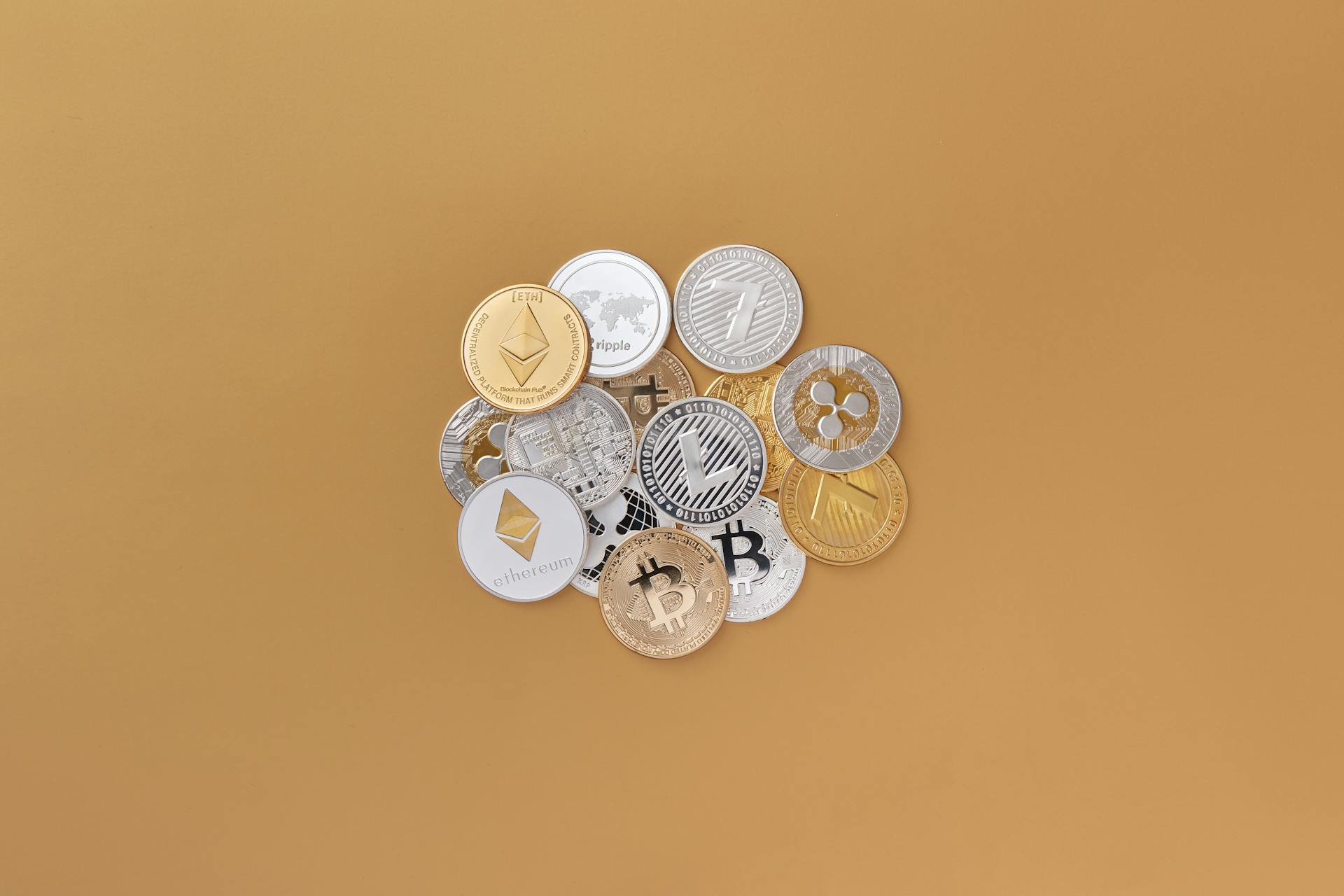
Decentralized finance courses are popping up everywhere, and for good reason - they're a game-changer for anyone looking to learn about the latest developments in the world of finance.
Decentralized finance, or DeFi, is a rapidly growing field that's revolutionizing the way we think about money and finance. With DeFi, you can lend, borrow, and trade assets without the need for intermediaries like banks.
DeFi courses can be found online and in-person, and they cover a wide range of topics, from the basics of blockchain technology to advanced concepts like yield farming and liquidity provision. By taking a DeFi course, you can gain a deeper understanding of the underlying technology and strategies that are driving this new financial frontier.
Whether you're a seasoned investor or just starting out, DeFi courses are a great way to expand your knowledge and stay ahead of the curve.
You might like: Bookkeeping and Payroll Courses Online
What Is DeFi?
Decentralized Finance, or DeFi, is an umbrella term for a global financial system operating on public blockchains.
The term DeFi was coined in 2018 by a group of entrepreneurs and Ethereum developers who wanted to create an alternative to traditional finance.
DeFi uses technology to create a peer-to-peer marketplace to facilitate transactions, replacing the middleman, such as banks or brokerage firms.
Smart contracts are the critical innovation that drives DeFi, allowing for complex transactions between individuals to run automatically on blockchains when predetermined conditions are met.
DeFi Total Value Locked (TVL) increased from $601 million at the start of 2020 to $239 billion near its high in 2022.
DeFi is redefining how financial products and services are consumed, changing how financial primitives are structured and traded, and allowing new financial products to be built and deployed with instant global reach.
DeFi apps are open source, allowing any developer to innovate and create new applications, and are like "money legos" that can be snapped together to build new financial products and services.
Anyone with a network connection can build or access DeFi applications as soon as they are deployed on the blockchain.
Readers also liked: Build Finance DAO
DeFi is lower cost because it removes middlemen like banks and brokerages from financial transactions.
Payment settlement times can go from days to minutes in DeFi, and complex transactions can be automated by coding the appropriate logic into a smart contract.
The existing TVL in DeFi is just the tip of the iceberg, with the global financial services market estimated to be worth over $23.3 trillion, and DeFi currently accounting for less than ½ % of the total.
Discover more: Cna Programs with Financial Aid
Getting Started with DeFi
To get involved in decentralized finance, you'll need to research the activities that interest you the most, such as lending, borrowing, or yield farming. This will help you identify the type of wallet and exchange you need to use.
You'll need a wallet that accepts DeFi apps, and Coinbase Wallet is a good option to start with. Add cryptocurrency to your wallet by purchasing some on an exchange, and then find a reputable exchange that provides the activity you want to get involved in.
To begin, set up a wallet, add cryptocurrency, and find a DeFi app that suits your needs. For example, if you're interested in borrowing or lending, you can use a platform like Compound or Aave.
Here's a step-by-step guide to getting started with DeFi:
- Set up a wallet that accepts DeFi apps
- Add cryptocurrency to your wallet by purchasing some on an exchange
- Find a DeFi app for the activity you want to get involved in
- Add your crypto to the app to begin
DeFi Certificate Program
The DeFi Certificate Program is an excellent way to get started with DeFi. You'll gain a strong foundation in Blockchain technology and its applications beyond DeFi.
In this program, you'll understand the basic concepts of Blockchain and analyze DeFi applications. This will give you a solid understanding of how DeFi works and its potential.
You'll learn to analyze the Characteristics of DeFi and its security issues. This is crucial in evaluating the risks associated with different DeFi projects.
The program will also teach you to evaluate the DeFi tools built on different platforms. This will help you navigate the complexities of the DeFi landscape confidently.
By the end of the program, you'll possess the knowledge and skills to assess investment opportunities and evaluate the risks associated with different DeFi projects.
Curious to learn more? Check out: Cryptocurrency Security Risks
Who Should Attend
If you're interested in getting started with DeFi, there are several types of individuals who can benefit from learning more about it. This includes those who are new to the world of finance and want to learn more about decentralized systems.
To get started with DeFi, you'll need a wallet that accepts DeFi apps, and there are many options to choose from. You can find a reputable exchange that provides the activity you want to get involved in or use, buy some cryptocurrency, and get started.
The Decentralized Finance (DeFi) ecosystem is a complex space, and understanding its core aspects is crucial for navigating it confidently. This includes analyzing various DeFi protocols, evaluating their security risks, and exploring the future of this dynamic space.
If you're interested in learning more about DeFi, you can enroll in a course that comprehensively introduces the Decentralized Finance (DeFi) ecosystem. This will provide you with a strong foundation in Blockchain technology and its applications beyond DeFi.
Here are some key characteristics of DeFi that you should be aware of:
- Decentralized finance, or DeFi, is an emerging peer-to-peer system attempting to remove third parties and centralized institutions from financial transactions.
- DeFi consists of cryptocurrencies, blockchain technology, and software that allows people to transact financially with each other.
- DeFi is still in its infancy and subject to hacks and thefts because of sloppy programming and a lack of security testing before applications are launched.
DeFi Basics
Decentralized finance (DeFi) is an emerging peer-to-peer financial system that uses blockchain and cryptocurrencies to allow people to transact directly with each other.
The key principle behind DeFi is to remove third parties like banks from the financial system, thereby reducing costs and transaction times. This is a game-changer for individuals who want more control over their financial transactions.
To get involved in DeFi, you'll need a wallet that accepts DeFi apps. You can choose from many wallets, but it's essential to research and find one that appeals to you.
Here are some basic steps to get started with DeFi:
- Set up a wallet that accepts DeFi apps
- Add cryptocurrency to your wallet by purchasing some on an exchange
- Find a DeFi app for borrowing, lending, liquidity, yield farming, or other activities
- Add your crypto to the app to begin
How It Works
DeFi uses peer-to-peer financial networks to eliminate intermediaries like banks and other financial service companies.
These networks rely on security protocols, connectivity, software, and hardware advancements to facilitate transactions.
Blockchain technology plays a crucial role in DeFi by reducing the need for intermediaries.
DeFi eliminates the need for intermediaries like banks, which charge businesses and customers for using their services.
If this caught your attention, see: Peer to Peer Exchange Crypto
Finance
Decentralized finance, or DeFi, is a peer-to-peer financial system that uses blockchain and cryptocurrencies to enable direct transactions between individuals and businesses.
DeFi eliminates the need for intermediaries like banks, which can reduce costs and transaction times. This system is designed to be more accessible and efficient than traditional financial institutions.
DeFi uses blockchain technology to secure transactions and reduce the need for intermediaries. A blockchain is a distributed and secured database or ledger that records transactions in blocks, which are then verified through automated processes.
Smart contracts, which are programs that execute specific actions when certain conditions are met, are used to govern DeFi transactions. These contracts are stored on blockchains and can be accessed by anyone in the network.
Transactions in DeFi are secure because they are recorded on a blockchain, which prevents tampering and ensures that once a transaction is made, it cannot be reversed.
DeFi enables individuals to hold private keys to tokens or cryptocurrencies, which act like passwords to access virtual tokens that represent value.
On a similar theme: Bitcoins Transactions per Second
Stablecoins
Stablecoins are a crucial part of DeFi, allowing for everyday transactions without the risk of extreme price fluctuations.
Stablecoins are pegged to a stable asset, like the U.S. dollar, to maintain a consistent value.
One example is DAI, issued by MakerDAO on the Ethereum blockchain, which is pegged to the U.S. dollar and collateralized by Ether.
DAI is overcollateralized by Ether, ensuring its value remains stable even if Ether's value fluctuates.
Another stablecoin is USDC, which is also pegged to the U.S. dollar, but its collateral is held in a centralized bank account.
USDC stablecoins are backed by a reserve of U.S. dollars, providing an extra layer of security for users.
You might like: Are Stablecoins Safe
DeFi Applications
DeFi applications provide an interface that automates transactions between users by giving them financial options to choose from. These applications are programs installed on a device like a personal computer, tablet, or smartphone that make it easier to use.
DeFi applications allow users to communicate with a blockchain, enabling them to use their money for purchases, loans, gifts, trading, or any other way they want without a third party. They automate transactions between users by giving them financial options to choose from.
A unique perspective: Cna Classes Online with Financial Aid
Some DeFi applications let you enter parameters for the services you're looking for and match you with another user. Because the blockchain is a global network, you can give or receive financial services to or from anywhere in the world.
Here are some examples of DeFi applications:
- Borrowing and lending services
- Yield farming
- Liquidity provision
Decentralized finance does not provide full anonymity. Transactions do not include an individual's name but are traceable by anyone with the knowledge to do so.
Exchanges
Exchanges play a crucial role in the DeFi ecosystem. You can choose between centralized exchanges, like Coinbase, and decentralized exchanges, or DEXs, which use smart contracts to facilitate transactions.
DEXs offer a more secure option, as users retain full control of their cryptocurrency holdings and don't have to deposit them in a centralized exchange. This reduces the risk of hacking and gives users more freedom.
To use a DEX, you'll need to find one that suits your needs, such as MDEX. Creating liquidity by supplying cryptocurrency can earn you income through transaction fees.
Here are some key differences between centralized and decentralized exchanges:
Before getting started with a DEX, you'll need to set up a wallet that accepts DeFi apps. Some exchanges, like Coinbase, already offer wallets that meet this requirement.
Prediction Markets
Prediction markets are a game-changer in the world of DeFi, allowing people to bet on the outcomes of events with better odds and lower fees.
DeFi prediction markets are much harder for central authorities to dismantle compared to standard sportsbooks.
The associated fees are lower, and market participants can bet on anything in unlimited amounts.
Prediction markets can provide value beyond increased access to gambling, as stock market predictions weighted by the size of the bets behind them are often fairly accurate.
For another approach, see: Bet with Bitcoins
Borrowing and Lending
Borrowing and lending are two of the most traditional functions enabled by DeFi. This allows users to borrow money by using their cryptocurrency holdings as collateral, or lend their cryptocurrency deposits to earn interest from borrowers.
You can use your cryptocurrency holdings as collateral to borrow money, and the interest rates will automatically adjust based on the changing supply and demand of the cryptocurrency. This is made possible by decentralized applications (dapps) that facilitate borrowing and lending.
One such dapp is Aave, a "decentralized non-custodial liquidity market protocol" that allows anyone to participate as a liquidity supplier or borrower. Aave lets you stake any of your crypto assets to earn interest income from users who might borrow your assets.
Lending your cryptocurrency deposits can be a profitable way to earn interest without triggering taxable events. However, it's essential to research and choose a reputable dapp to ensure a smooth experience.
Here's a step-by-step guide to borrowing and lending in DeFi:
- Choose a reputable dapp like Aave to facilitate borrowing and lending
- Use your cryptocurrency holdings as collateral to borrow money
- Lend your cryptocurrency deposits to earn interest from borrowers
Applications
DeFi applications make it easier to use decentralized finance by providing an interface that automates transactions between users.
These applications are programs installed on devices like personal computers, tablets, or smartphones, making it simpler to use decentralized finance without needing to be familiar with the command line or terminal.
DeFi applications give users financial options to choose from, such as making a loan to someone and charging interest, or searching for providers to lend cryptocurrency.
Some applications let you enter parameters for the services you're looking for and match you with another user, making it possible to give or receive financial services from anywhere in the world.
Transactions on DeFi applications are not fully anonymous, as they can be traced by anyone with the knowledge to do so, including governments and law enforcement.
Expert Insights
Decentralized finance, or DeFi, is a rapidly growing field that's changing the way we think about finance. Dr. Christine Parlour, a professor at the Haas School of Business, University of California, Berkeley, is one of the experts who's helping us understand DeFi.
Dr. Jimmie Lenz, Director of Duke University's Master of Engineering in FinTech and Master of Engineering in Cybersecurity, notes that DeFi involves the use of blockchain technology to create new financial instruments and services. This is a key aspect of DeFi that's making it so attractive to investors and entrepreneurs.
You might enjoy: Columbia University Value Investing Program
Dr. Merav Ozair, a FinTech Professor at Rutgers Business School, emphasizes the importance of education and training in the DeFi space. She believes that understanding the underlying technology and concepts is crucial for success in DeFi.
To get started with DeFi, it's essential to have a solid foundation in finance and technology. Dr. Parlour recommends starting with courses that cover the basics of blockchain and cryptocurrency.
DeFi Uses and Benefits
Decentralized finance, or DeFi, is a game-changer for financial services. DeFi offers a permissionless, open-access system where anyone with a crypto wallet and internet connection can participate.
Decentralized exchanges are the top preference for DeFi app users, allowing them to interact with other cryptocurrency users. This is a huge advantage over traditional financial institutions, which often have limited access and high fees.
Decentralized exchanges like Uniswap and PancakeSwap have apps that let users trade cryptocurrencies directly with each other, cutting out intermediaries and reducing fees. This is a major benefit of DeFi.
If this caught your attention, see: Bitcoin Atm Milwaukee - Coinhub
DeFi platforms also enable lending and yield farming, where users can lock their funds in a pool and earn interest on their loans. This is a great way to earn passive income, but it's essential to do your research before participating.
Liquidity providers are another key part of the DeFi ecosystem, providing pools of funds for users to draw from. This helps to facilitate trades and reduce the risk of buying and selling cryptocurrencies.
Here are some of the most popular DeFi uses:
- Decentralized exchanges
- Liquidity providers
- Lending/Yield Farming
- Gambling/Prediction Markets
- NFTs
These DeFi uses offer a range of benefits, including increased transparency, security, and accessibility. They also provide new opportunities for earning passive income and participating in the financial system.
DeFi Example and Uses
Decentralized finance, or DeFi, is a way for people to send and receive money directly to each other using their devices and cryptocurrency.
You can get involved in DeFi by researching activities that interest you, such as lending or yield farming, and finding a reputable exchange that provides the activity you want to get involved in. For example, Aave is a notable DeFi service provider that allows anyone to participate as a liquidity supplier or borrower.
Aave lets you stake any of your crypto assets to earn interest income from users who might borrow your assets. This is a great way to earn passive income in DeFi.
Decentralized exchanges, liquidity providers, lending/yield farming, and NFTs are just a few of the many sectors or endeavors you can participate in within DeFi. These activities can be accessed through various DeFi apps, such as Uniswap and PancakeSwap.
Here are some popular DeFi uses:
- Decentralized exchanges: Exchanges like Uniswap and PancakeSwap let you interact with other cryptocurrency users.
- Liquidity providers: Liquidity providers are pools where users place funds so exchanges can provide selling opportunities for their users.
- Lending/Yield Farming: DeFi apps provide lending services, where users lock their funds in a pool and let others borrow them, receiving interest on their loans.
- Gambling/Prediction Markets: DeFi apps like Polymarket and ZKasino let you place bets on the outcome of nearly any event.
- NFTs: Non-fungible tokens are still popular with niche investors and collectors.
Sources
- https://timespro.com/online-courses/decentralised-finance-de-fi-principles-and-concepts
- https://consensys.io/blockchain-use-cases/decentralized-finance
- https://www.fool.com/terms/d/decentralized-finance/
- https://www.investopedia.com/decentralized-finance-defi-5113835
- https://www.amberdata.io/defi-decentralized-finance-primer
Featured Images: pexels.com


